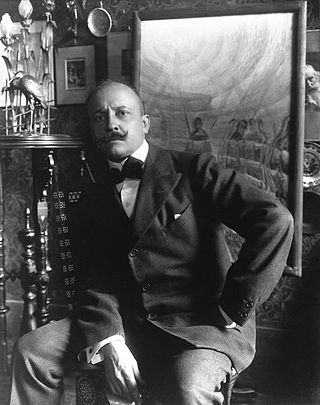
Filippo Tommaso Emilio Marinetti was an Italian poet, editor, art theorist, and founder of the Futurist movement. He was associated with the utopian and Symbolist artistic and literary community Abbaye de Créteil between 1907 and 1908. Marinetti is best known as the author of the Manifesto of Futurism, which was written and published in 1909, and as a co-author of the Fascist Manifesto, in 1919.

Futurism was an artistic and social movement that originated in Italy, and to a lesser extent in other countries, in the early 20th century. It emphasized dynamism, speed, technology, youth, violence, and objects such as the car, the airplane, and the industrial city. Its key figures included Italian artists Filippo Tommaso Marinetti, Umberto Boccioni, Carlo Carrà, Fortunato Depero, Gino Severini, Giacomo Balla, and Luigi Russolo. Italian Futurism glorified modernity and, according to its doctrine, "aimed to liberate Italy from the weight of its past." Important Futurist works included Marinetti's 1909 Manifesto of Futurism, Boccioni's 1913 sculpture Unique Forms of Continuity in Space, Balla's 1913–1914 painting Abstract Speed + Sound, and Russolo's The Art of Noises (1913).

Giuseppe Ungaretti was an Italian modernist poet, journalist, essayist, critic, academic, and recipient of the inaugural 1970 Neustadt International Prize for Literature. A leading representative of the experimental trend known as Ermetismo ("Hermeticism"), he was one of the most prominent contributors to 20th century Italian literature. Influenced by symbolism, he was briefly aligned with futurism. Like many futurists, he took an irredentist position during World War I. Ungaretti debuted as a poet while fighting in the trenches, publishing one of his best-known pieces, L'allegria.

Italian futurist cinema was the oldest movement of European avant-garde cinema. Italian futurism, an artistic and social movement, impacted the Italian film industry from 1916 to 1919. It influenced Russian Futurist cinema and German Expressionist cinema. Its cultural importance was considerable and influenced all subsequent avant-gardes, as well as some authors of narrative cinema; its echo expands to the dreamlike visions of some films by Alfred Hitchcock.

Giovanni Papini was an Italian journalist, essayist, novelist, short story writer, poet, literary critic, and philosopher. A controversial literary figure of the early and mid-twentieth century, he was the earliest and most enthusiastic representative and promoter of Italian pragmatism. Papini was admired for his writing style and engaged in heated polemics. Involved with avant-garde movements such as futurism and post-decadentism, he moved from one political and philosophical position to another, always dissatisfied and uneasy: he converted from anti-clericalism and atheism to Catholicism, and went from convinced interventionism – before 1915 – to an aversion to war. In the 1930s, after moving from individualism to conservatism, he finally became a fascist, while maintaining an aversion to Nazism.

Giovanni Amendola was an Italian journalist, professor, and politician. He is noted as an opponent of Italian fascism.

Ardengo Soffici was an Italian writer, painter, poet, sculptor and intellectual.

Giuseppe Prezzolini was an Italian literary critic, journalist, editor and writer. He later became an American citizen.
BÏF§ZF+18 Simultaneità e Chimismi lirici is a poetry book and artist's book published in 1915 by the Italian futurist Ardengo Soffici. Despite its rarity, the book has become famous as one of the finest examples of futurist 'words-in-freedom', and has been described as 'absolutely the most important book that came out of Florentine Futurism'.
Valori plastici was an Italian magazine published in Rome in Italian and French. The magazines existed between 1918 and 1922.

Lacerba was an Italian literary journal based in Florence closely associated with the Futurist movement. It published many Futurist manifestos by Filippo Marinetti, Antonio Sant'Elia, and others.
Il Frontespizio was an art and literary magazine, which had a Catholic perspective. The magazine existed between 1929 and 1940 and was based in Florence, Italy.
Alberto Spaini was an Italian journalist-commentator and author. He was also a scholar of German literature, producing through his career many translations into Italian of traditional and contemporary German classics.
Il Selvaggio was a political and arts magazine that existed between 1924 and 1943. It was a media outlet of an intellectual group called Strapaese.
Leonardo was a philosophy magazine published in the early twentieth century in Florence, Italy, between 1903 and 1907. It was one of the publications started by Giovanni Papini and contributed by Giuseppe Prezzolini. The magazine is also one of the periodicals which contributed to the cultural basis of the early forms of Fascism.
La Lupa was a weekly magazine which was published in Florence, Italy, in the period 1910–1911. Although it existed for a short period, it is known to be one of the publications which laid the foundations of the fascist governments in the following years.
Critica fascista was a biweekly cultural magazine which was founded and edited by Giuseppe Bottai in Rome, Italy. The magazine existed during the Fascist rule in the country from 1923 to 1943. Over time it became one of the most significant publications of the fascist period in Italy.
La Gaceta Literaria was a bimonthly avant-garde literary, arts and science magazine which appeared in Madrid, Spain, between 1927 and 1932. It is known for its leading contributors and editorial board members.

La Ronda was a literary magazine which existed in Rome, Kingdom of Italy, between April 1919 and November 1922. In December 1923 a special issue was also published.
La Raccolta was a monthly literary magazine which was published in Bologna, Italy, between March 1918 and February 1919. It was one of the significant platforms for the discussions about the development of a new approach towards Italian literary movements in the country during its run.










